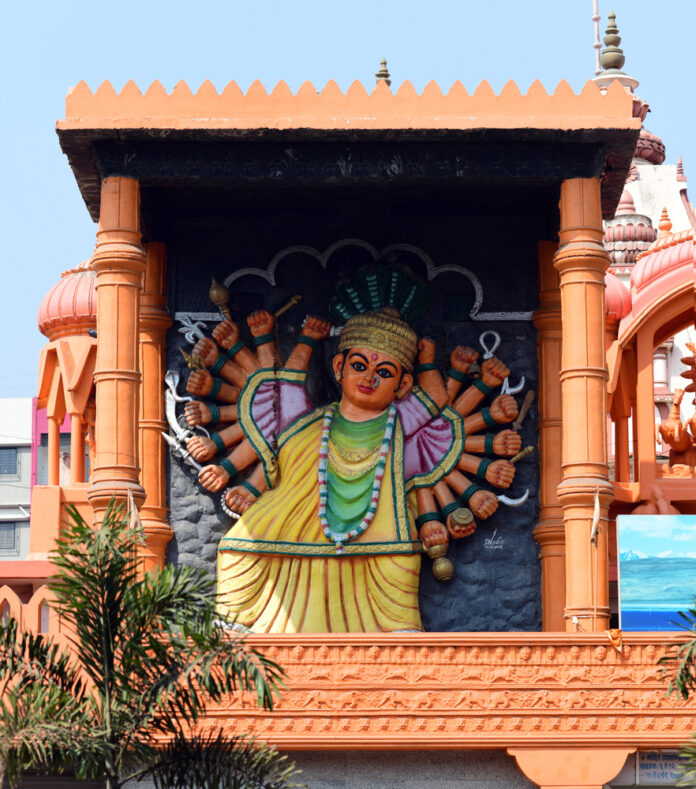Saptashrungi Mata Mandir Nashik Maharashtra
Saptashrungi Mata Mandir, located near Nanduri village in Maharashtra, is a renowned pilgrimage site dedicated to Goddess Saptashrungi. The temple is nestled amidst the seven hills (Saptashrungi) and offers breathtaking views of the surrounding landscapes. Devotees flock to this sacred place to seek the blessings of Goddess Saptashrungi, who is believed to fulfill their wishes and desires. Let’s delve into the history, timings, and how to reach this divine destination.
Saptashrungi Mata Mandir History
Saptashrungi Mata Mandir, located near Nanduri village in Maharashtra, has a rich and fascinating history deeply rooted in Hindu mythology. The temple is dedicated to Goddess Saptashrungi, also known as Goddess Bhagwati or Jagadamba. The name “Saptashrungi” is derived from the Sanskrit words “Sapta” meaning seven and “Shrungi” meaning peaks, referring to the seven hills that surround the temple.
Mythological Significance
According to Hindu mythology, the Saptashrungi Mata Mandir is considered one of the 51 Shakti Peethas, where various body parts of Goddess Sati, the first wife of Lord Shiva, are believed to have fallen after her self-immolation. It is said that when Lord Shiva carried Sati’s body, distraught over her death, Lord Vishnu used his Sudarshan Chakra to dismember Sati’s body, which fell at different spots across the Indian subcontinent. The right arm of Sati is believed to have fallen at the location where the Saptashrungi Mata Mandir stands today.
Historical References
The history of Saptashrungi Mata Mandir dates back to ancient times, with references found in various Hindu scriptures and texts. The temple has been mentioned in the “Devi Bhagwat Purana” and the “Markandeya Purana,” highlighting its significance as a revered place of worship.
Renovation and Development
Over the centuries, the Saptashrungi Mata Mandir has undergone several renovations and developments, enhancing its architectural beauty and spiritual significance. The temple complex includes the main shrine dedicated to Goddess Saptashrungi, along with other smaller shrines dedicated to various deities.
Architectural Marvel
The temple’s architecture is a blend of traditional and modern styles, with intricate carvings and sculptures adorning its walls and pillars. The main sanctum sanctorum houses the idol of Goddess Saptashrungi, depicted with eight arms, holding various weapons and symbols of power.
Spiritual Significance
Saptashrungi Mata Mandir holds immense spiritual significance for devotees, who believe that worshipping here can bring peace, prosperity, and fulfillment of desires. The temple is visited by thousands of devotees every year, especially during the Navratri festival, to seek the blessings of Goddess Saptashrungi.
Significance of Saptashrungi Mata Temple
The Saptashrungi Mata Temple holds immense significance for devotees and visitors alike. Here are some key aspects of its importance:
Spiritual Significance
- Goddess Saptashrungi: The temple is dedicated to Goddess Saptashrungi, a form of Goddess Bhagwati or Jagadamba. Devotees believe that worshipping her can bring peace, prosperity, and fulfillment of desires.
- Shakti Peetha: The temple is considered one of the 51 Shakti Peethas, where the body parts of Goddess Sati are believed to have fallen after her self-immolation. The right arm of Sati is said to have fallen here, making it a sacred site for Shakti worshippers.
Cultural Heritage
- Historical and Mythological Significance: The temple’s history is deeply rooted in Hindu mythology, with references found in ancient scriptures and texts. It is a symbol of Maharashtra’s rich cultural heritage.
- Religious Practices: Various religious practices and rituals are performed at the temple, including Aarti, Abhishekam, and special poojas, especially during festivals like Navratri.
Architectural Marvel
- Blend of Styles: The temple’s architecture is a blend of traditional and modern styles, with intricate carvings and sculptures that showcase the skill and craftsmanship of artisans.
- Sacred Sanctum: The main sanctum sanctorum houses the idol of Goddess Saptashrungi, depicted with eight arms, holding various weapons and symbols of power.
Pilgrimage Destination
- Pilgrimage Site: The temple is a popular pilgrimage site, attracting thousands of devotees and tourists every year, especially during the Navratri festival.
- Spiritual Experience: Visiting the temple is not just a religious experience but also an opportunity to experience divine tranquility amidst the scenic beauty of the seven hills.
Saptashrungi Mata Mandir Timings
- Temple Opening Hours: The temple is open for devotees from early morning till late evening.
- Aarti Timings: The morning and evening Aarti timings are considered auspicious, attracting a large number of devotees.
- Special Occasions: During festivals and special occasions, the temple timings may vary, and additional Aartis and ceremonies are conducted.
How to Reach Saptashrungi Mata Mandir
By Air
- Nearest Airport: The nearest airport to Saptashrungi Mata Mandir is Chhatrapati Shivaji Maharaj International Airport in Mumbai, located approximately 260 kilometers away.
- Connectivity: From the airport, visitors can hire taxis or take buses to reach the temple.
By Train
- Nearest Railway Station: The nearest railway station to Saptashrungi Mata Mandir is Nashik Road Railway Station, located around 75 kilometers away.
- Connectivity: From Nashik Road Railway Station, visitors can hire taxis or take buses to reach the temple.
By Road
- Road Connectivity: Saptashrungi Mata Mandir is well-connected by road, and buses and taxis are available from major cities like Mumbai, Pune, and Nashik.
- Route: The temple is located around 60 kilometers from Nashik and can be reached via NH-3 and State Highway 31.
By Bus
Accommodation and Facilities
- Accommodation: There are several budget and mid-range hotels and lodges available near Saptashrungi Mata Mandir for visitors to stay.
- Facilities: The temple premises provide facilities like restrooms, drinking water, and shops selling religious items and souvenirs.
Tips for Visitors
- Footwear: It is customary to remove footwear before entering the temple premises.
- Dress Code: Visitors are advised to dress modestly and adhere to the temple’s dress code.
- Photography: Photography may be restricted in certain areas of the temple, so it is advisable to check with the authorities before clicking pictures.





